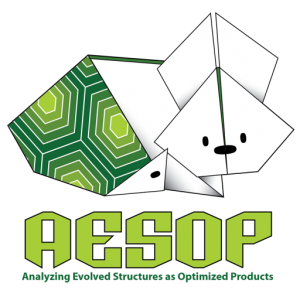 Center for Analyzing Evolved Structures as Optimized Products (AESOP): Science and engineering for the human habitat
Center for Analyzing Evolved Structures as Optimized Products (AESOP): Science and engineering for the human habitat
Director: Shu Yang (Materials Science & Engineering, SEAS)
Deputy Director: Randall D. Kamien (Physics & Astronomy, SAS)
Mission Statement. Though the progress of human invention has accelerated at an astounding pace from the ancient wheel, to wrought steel, to the modern widget, the products of natural selection and evolution over hundreds of millions of years dwarves mankind’s accomplishments. In order to address society’s ever more pressing need to conserve water, nutrients, energy, and sustainability in a highly diverse set of circumstances and environments, we aim to build a dynamic and highly collaborative center that will bring together materials scientists, chemical and biomolecular engineers, mechanical engineers, robotics engineers, systems engineers, computer scientists, architects and designers with expertise in both active and real time control of materials, metamaterials, and structures. It will have cross-cutting interactions with existing centers at Penn, including LRSM, PRECISE and GRASP, and Kleinman Center for Energy Policy, will go beyond fundamental questions in materials and structures, and find innovative solutions at the system level by creating a new paradigm of algorithmic design of products that transcends scales.
We will build new bridges across disciplines to turn our knowledge of convergently evolved systems in nature into disruptive and sustainable technology. To do so, we will connect engineers with evolutionary biologists, physicists, chemists and architects. In the form of buildable, foldable, responsive, and commodity-scale materials, we expect our technology will interact with, and thus, impact the human habitat in water, heat, and light management. We will search common motifs and designs that span and transcend species, for instance, in butterfly wings, pollen grains, insect trachea, and vascular structures in plants; investigate their convergent strategies, and design, fabricate and assemble such structures across the scales with optimized response to common environmental stresses.
Ties to LRSM. We will draw the knowledge from materials synthesis, fabrication, and assembly to develop new processes and strategies to create multi-scale materials and optimized products with a focus on impact to environmental sustainability, delopyability, and commodity in human habitat.
Ties to PRECISE. To integrate the technological innovation into a human habitat, it is essential to create interfaces between the devices and humans, and with humans within or on their habitat in a built environment. Therefore, embedded computing and integrated system engineering will be essential to optimize the concepts, solutions, and products developed through the center. Besides programming the passive responses of our structures to the local environment, we plan to introduce active control systems to direct energy management in real-time for maximum energy efficiency.
Ties to GRASP. The following Center activities have strong ties to GRASP interests of developing autonomous vehicles and robots, and self-configuring humanoids.
- Develop rules to scale up or scale down – geometry, topology – for controlled compliance and foldability (space saving and dramatic shape/volume change) with minimal waste, and efficient load distribution.
- Fabricate synthetic structures at length scales associated with the prevailing physics and chemistry with super-compliant, conformable, light-weight, dramatic shape changing effects and actuation, enabling actuation and mobility.
- Develop robotic, modular assembly algorithms for on-demand packaging of the components of functional materials across length scales over a large area. How can a developing tissue in an insect turn off and a year later turn on with no loss of continuity?
- Integrate dynamics from evolutionary timescales to construction and deployment timescales.
- Learn about macroevolution from the fossil record to address issues such as locomotion, defense, and durability.
Ties to Kleinman Center for Energy Policy. We will consult Kleinman Center to analyze jurisdictions on the basis of energy markets, local legislation and code implementation and barriers as well as regional climate conditions, and evaluate the value proposition of our prototypes. We will focus on applications that can be scaled up to provide real change to impact human habitat.
Intellectual Merit The Center will extend the concept of bio-prospecting — typically in the context of molecular biology and pharmaceuticals, to mine nature for its structures, materials, and their processing by bringing together evolutionary biology with the physical sciences and engineering, as well as bringing together engineers working on different system levels to make the whole greater than the sum of its parts. This particular untapped connection between scientists and engineers will not only lead to novel technologies but, most importantly to entirely new ideas, results, and realms. The Center will accelerate the discovery rate and technology advancement by bringing together faculty working on problems at very different scales (from nano- to human scales) to ask the same questions – how do we improve the synthetic ecosystems in which humans interact, just as organic and living as plants and other animals with their natural habitat, and how do we optimize energy efficiency and improve human health within their dwellings.
Impact. The science and technology developed through our Center will not be limited to buildings and indoor life. The flexible, buildable and packable devices could be applied to wearable electronics, optics and water collectors, deployable airplanes, drone add-ons, solar panels, and emergency relief housing. How they can change shape, orientation, or function depends at least in part on environmental conditions. The algorithms developed for systems engineering will provide us new tools to assemble linkages that are lightweight, strong, robust and adaptable. It will also offer new means of autonomous actuation and additive manufacturing.
Education and training. The research effort will be integrated with a suite of education and outreach efforts administered across the schools at Penn, including Arts & Sciences, Penn Engineering, and Penn Design.

